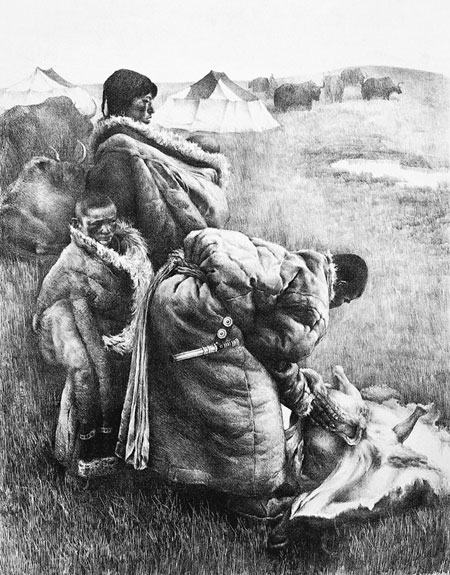
 |
|
Slaughtering a Lamb (1982). Photo provided to China Daily |
He recalls once spending hours yelling to a herder a few hundred meters away because he was afraid to get too close to the guard dog. Finally, he was able to get close enough to finish his painting.
This trip proved productive. He created a series of prints depicting Tibetan lifestyles and landscapes. Some of these, such as Tibetan Woman and Milking the Cow, have won several national and international awards.
It enabled him to make enough of a name for himself that he could have continued to create from the comfort of his studio.
But he has continued returning to Tibetan areas.
Wu's former colleague and CCAFA professor Song Xiaoxia recalls joining Wu for a bumpy ride from Qinghai's capital Xining to the province's Yushu Tibetan autonomous prefecture in 1997.
Their bus broke down halfway as dusk fell. They had to hitch rides from passing trucks.
"As I saw him fumble in the truck, with his painting supplies on his back and his easel buried in his chest, I realized he'd been on dozens of such rough trips," Song recalls.
"I had no idea he'd continue taking these journeys for the following 15 years."
|
|
Wu has persisted in making the trips, even after becoming extremely busy as the managing director of the China Artists Association in 2007.
He says it's the Tibetan people, especially the nomads, who create the magnetism that keeps pulling him to the area. He believes they are "heroes" who rule "the roof of the world".
His portraits show Tibetan herders as glorious statues with strong physiques, colorful attire and rotund faces. They express an assertiveness that resembles that of a triumphant military commander.
Wu says they display the virtues of diligence, courage, warm-heartedness and hospitality. "Some of these (qualities) are hard to find in today's commercialized world," he says.
Wu personally aspires to these characteristics, he says. "I think that's part of the reason I love to be there and paint the people," he says.
But Wu says Tibetans are changing, as urbanization and commercialization make inroads into their society.
More of his subjects wear athletic shoes, he says, so he now brings traditional Tibetan boots with him. It's increasingly commonplace for them to snap photos of his paintings of them with their mobile phones.
But while Wu laments the disappearance of some traditions and lifestyles, he says the Tibetans have taught him to view whatever happens in a positive light.
The essence of the virtues that draw him to Tibetan areas remain intact - even in the most urban locales, he says.
For example, many Tibetans have swapped their horses for motorcycles.
"But you instantly know they're Tibetans when you see them navigating the rutted roads," Wu says.
"They don't just drive motorcycles - they make them gallop."
Artist Pan Shixun, who has visited Tibetan areas since the 1960s and visited Ngari last year at age 80, says: "Every trip is a spiritual recharge for Wu and me."
Wu agrees. "My studio is wherever the Tibetan herders are."
Contact the writer at linshujuan@chinadaily.com.cn.
